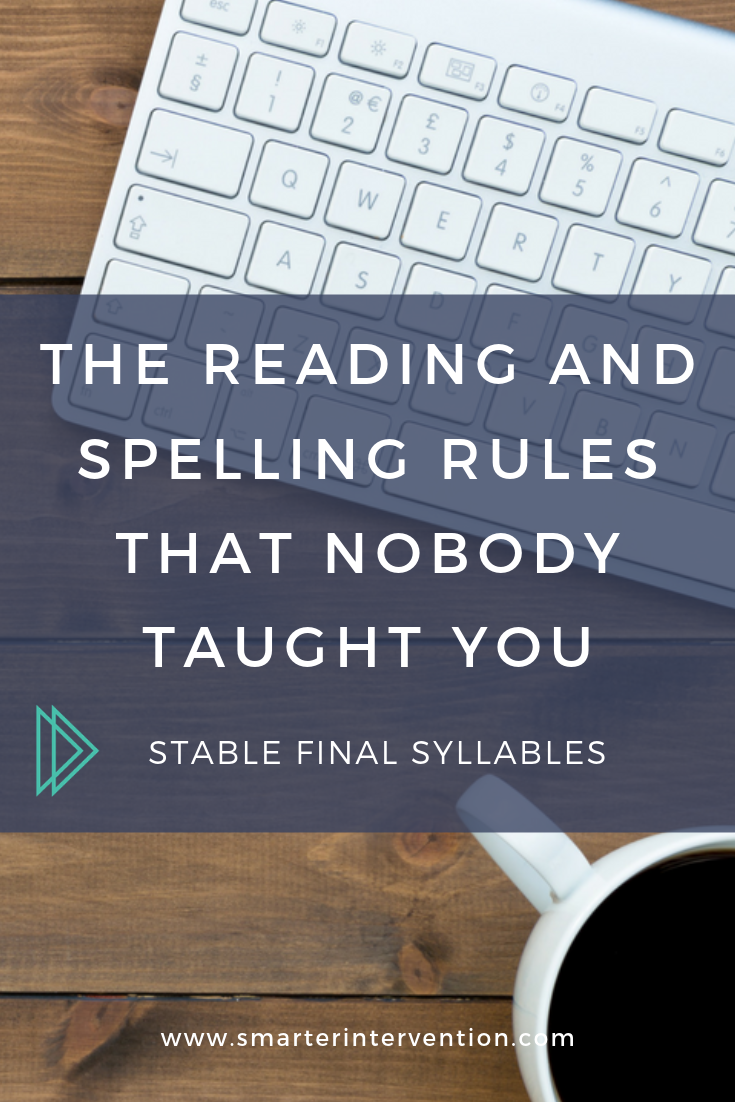Consonant LE Syllables - The Reading and Spelling Rules No One Ever Taught You
We’re back with more reading and spelling rules! If you’ve been following along, you know that we like to teach reading and spelling rules using the six syllable types.
Never heard of the six syllable types? Don’t worry (we hadn’t either!), you can read more about them here! Syllable types are important because they help to predict the vowel sound (which is usually the tricky part when reading and spelling).
Sometimes vowels create a short vowel sound, sometimes they create a long vowel sound, and sometimes (as we will see in Consonant -LE syllables) they are silent in order to create a syllable.
Today we are talking about one of the stable finally syllable patterns,
Consonant -LE Syllables
A consonant -LE syllable occurs when a consonant is followed by an “l” followed by an “e” (e.g., apple, turtle, doodle). The final “e” is silent and the consonant + l + e is divided as one syllable.
How To Teach Consonant LE Syllables - Reading Process
We always follow a step-by-step process to teach CLE syllables:
1 - Find/color the vowel in red
This is important because we need to be able to visually see the vowel to determine what type of syllable we have.
2 - If there is an “e” at the end of a syllable, check to see if there is an “l” before the “e”
E can play many roles at the end of a syllable and in this case, we are looking out to see which role that “e” may be playing.
3 - If there is an “l” before the “e”, check to see if there is a consonant before the “l”
If so, divide the syllable before the consonant. Knowing that consonant LE words need to be divided in this way will help us to know if the first syllable has a long or short sound. For example, the word raffle has two Fs to keep the first syllable closed. A closed syllable will keep the first syllable’s vowel sound short RAF-FLE. In words like cradle, you will get a long (open) vowel in the first syllable CRA-DLE.
4 - Read each syllable, then blend the syllables together to read the entire word
If there are multiple syllables, blend each syllable together to read the entire word. A syllable is a word or part of a word with one vowel sound so if there is more than one vowel followed by a consonant, the word has more than one syllable
How To Teach Consonant LE Syllables - Spelling Process
When teaching spelling, we like to use a 4-Step Process:
1 - Identify how many syllables are in the word
We like to have students scoop the syllables, this is important because each syllable needs at least one vowel sound (which might be a consonant -le syllable!)
2 - Identify how many sounds are in the word
We like to have students underline or dot the number of sounds they hear.
3 - Identify the type of sound
Is the sound a vowel sound or a consonant sound? Is the vowel sound short or long?
4 - Identify the type of syllable
This is important because specific syllable types have specific spelling rules including consonant -le patterns.
Let’s look at apple for example…
Why don’t we spell “apple” as “apl”?
The word apple has 2 syllables, not 1. If you clap out the word apple you will hear two syllables. /a/- /pl/. Because the word has 2 syllables it needs at least 2 vowels. So (as per usual), E steps into the job and hangs out silently at the end of the word. Okay, we are used to adding Silent E’s to the end of the words but that begs the question why not just leave it at APLE? Good question...
When a word ends with an L-E we need to check to see if a consonant will precede the L-E, if it does we have a syllable division rule that dictates “consonant L-E count back 3” which would mean we would divide the word as A-PLE. Dividing the word in that way will leave the A open. Open syllables require the vowel to say their long sound so we would end up with APLE rhyming with MAPLE.
Consonant LE Spelling Patterns
Consonant LE makes a big impact on spelling, but this is one of the last syllable types we teach because students need to have an understanding of all other syllable type patterns BEFORE jumping in here. For example…
If you identify a CLE syllable and the previous syllable is closed, the vowel sound will be short
If you identify a CLE syllable and the previous syllable is open, the vowel sound will be long
If you identify a CLE syllable and the previous syllable is R-controlled, it will follow the R-controlled sound patterns
If you identify a CLE syllable and the previous syllable is a vowel team, it will follow the vowel team sound patterns
This is a quick rundown of the importance of this syllable type but it certainly is a nice one to really see the power of the syllable types and knowledge of how all six syllable types work together to create words. Understanding the syllable types adds so much breadth and depth of understanding of the “WHY?!?!” of the English Language.
How do I get started?
If you need help mastering all these rules, we’ve got you. We put all the rules we teach together in our Comprehensive Rules Guide which you can grab here! It’s a fabulous place to get started.
Or, if you’re ready for the next step and you’re looking for comprehensive lesson materials to explicitly teach all of the phonogram patterns, you can check out our systematic phonics-based curriculum, Delivering SMARTER Intervention here.






